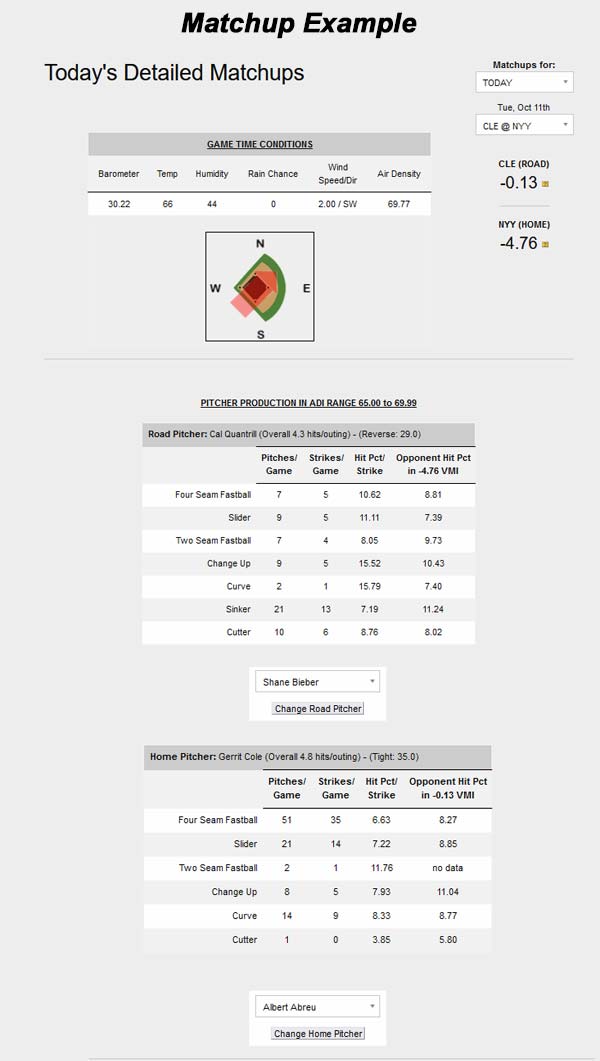

 Detailed Matchups Introduction
Detailed Matchups IntroductionWe have made a big deal of the "Detailed Match-Ups" provided to our members. The following is an example of what the members are able to see each day of the season for all MLB games. As we have explained in numerous places on our web-site, we realize that this does not constitute the whole of baseball, nor does it indicate who will win the matchup. However, there are some tendencies that all teams display in their production which should not be overlooked when attempting to wager or to pick the best pitcher for your fantasy league. Even the pro's should take a look at the conditions they will play within today.
Keep in mind that the ADI is the actual air density on the "Neeley Scale," which identifies the base amount of movement today's pitchers will have available to them on each of their various pitches. The VMI, on the other hand, identifies how long it has been since the team of hitters played in this amount of "ADI-based" movement.
At the bottom of the page, we have provided you with a description of pitchers who make different pitches their primary or secondary pitch.
 You may need to refer to articles on http://dailybaseballdata.com written by Clifton Neeley to see more tendencies these pitcher categories identify. A standard membership qualifies you for the daily access to this detail.
You may need to refer to articles on http://dailybaseballdata.com written by Clifton Neeley to see more tendencies these pitcher categories identify. A standard membership qualifies you for the daily access to this detail.
The pitcher type displays a quantifier, as well. Following the pitcher type is a calculated magnitude of each pitcher's mix of pitches. It is intended to provide you a weighting within each designation. The primary pitches which make up the "Type" are weighted more heavily and the secondary pitches he uses within his mix receive a lesser weighting. Therefore it is a reflection of his reliance on the major pitches. The higher the "rating", the more closely his pitch mix is conformed to his designation and the more he depends on the best of its pitch-types. If he has a low rating it means his mix includes pitches that may be closely identified with a different pitch-type. In other words a "low" rating after a tight pitcher may indicate he is close to being a "loose" pitcher. As you watch the rating, you may begin to see a pattern for effectiveness against a particular VMI range, or within a particular ADI range.
| The Loose Pitcher (he throws several off-speed pitches, but not many Four-Seamers)--reviews of the data are mixed, because he is better against a High Plus VMI team in a High ADI, but he is usually worse against the High Negative VMI team and in Low ADI's. But, because the pitches are typically slower--even this is tough to call due to mental focus of the hitting team. An over aggressive team that is pressing will stay off-balance due to the slower speeds; but a team that is relaxed and having fun is likely to pound this pitcher. | The Tight Pitcher (remember, this pitcher throws the Four-Seamer primarily and the Slider and Curve) is better against a Low (+ or -) VMI team, or a Negative VMI team, but will get hit harder in thin air environments (below 60 ADI such as Atlanta, Texas, Kansas City, Arizona and of course Colorado) that typically generate high plus VMIs. | The Reverse Pitcher (he is a Sinker Ball pitcher, or a higher than normal number of Two-Seamers) - better against the High Plus VMI team, but worse in the Higher Negative VMI team outings. This, of course, is due to the hitter's "Visual Memory" causing him to set up to deal with the upward lifting Four-Seamer, plus being able to identify and change his body position (within a half second) to hit the lesser lifting Two-Seamer and downward breaking Sinker, Slider, Curve, etc. |
| The Knuckleball Pitcher (Obviously he concentrates primarily on the Knuckleball) - he is always a tough pitcher to deal with, but most likely more so in the Welterweight ADI atmospheres where most teams play the largest portion of their schedules. Interestingly, pitchers avoid throwing the Knuckleball in the very heaviest air that we have labeled Heavyweight. Furthermore, the Knuckleballs thrown in the lower 70s ADI haven't been super successful either. Although it would seem that a pitcher could get really good movement on this diving, darting and hopping pitch in the heaviest of air, he will have difficulty keeping spin off the Knuckleball which can lead to more homers in MLB. Since the heaviest of air is also going to be the coldest air at sea level, then one can imagine that the bitter cold would have an effect on the pitcher's grip, feel and comfort. Add to those issues the fact that all his other pitches should be effective in the heaviest air, and the fact that any speed Four-Seamer will be more difficult to hit at cold sea level locations, and you can see why a Knuckleball pitcher may choose them over the Knuckleball. | ||

© 2020 Air Resistance Technologies, Inc., All Rights Reserved.
BaseballVMI.com, 1326 51st Avenue, Greeley, CO. 80634